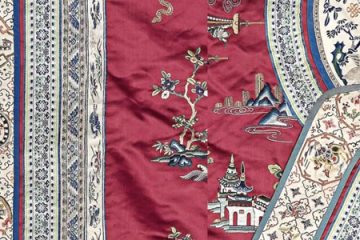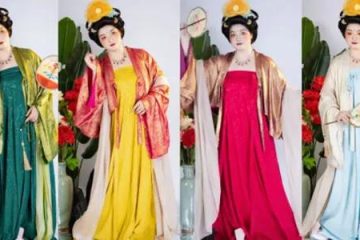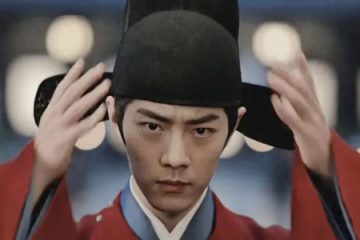Can You Leave Strands of Hair on Both Sides When Wearing Hanfu? The Answer Is Here!

Struggling with how to style your hair for Hanfu? It can definitely feel overwhelming—so you might be tempted to just leave two loose strands at the sides as bangs. Sounds familiar? If that’s you, this blog might just have the answers you’re looking for.
In the historical drama The Story of Minglan, there’s a scene that mentions “loosening the bun and letting hair fall like those brothel styles.” This refers to the look of leaving two wispy strands of hair hanging on the sides—something historically associated with more provocative or “dusty” looks. But is that really where the style comes from? And if so, have most modern period dramas gotten it wrong?
Ⅰ. What’s the deal with the two side bangs?
Today, many people jokingly call this look “catfish whiskers,” but it actually does have historical roots. During the Han and Jin dynasties—especially after the Eastern Han—it was common to see two long strands of hair hanging down the sides, a style known as chuí tiáo (垂髫). This was typically seen in depictions of immortals in Wei and Jin art, or in hairstyles for children during that time

Strictly speaking, this kind of chuí tiáo isn’t actually bangs. It refers to neatly sectioned strands of hair left hanging from the main bun, forming a decorative part of the hairstyle.
This side-hanging style only stayed popular for a relatively short period, mainly during the Wei and Jin dynasties—what many refer to as the era of “Wei-Jin elegance.”
Ⅱ. The “Catfish Whiskers” Look in TV Dramas

The “catfish whiskers” hairstyle we often see in modern period dramas isn’t quite the same as the traditional chuí tiáo. Even though later generations admired the grace and elegance of the Wei and Jin periods, their idea of “elegance” meant refined and composed—not messy or disheveled.
In contrast, today’s “catfish whiskers” style—those two loose, dangling strands—tend to be overly relaxed, sometimes looking messy on purpose to create a casual, undone vibe. But this attempt at a “stylish mess” often ends up either too sloppy or too stiff. It’s no surprise some critics refer to it as the “brothel style” mentioned in historical dramas—it does lean more toward theatrical flair than historical accuracy.

Outside of dramas specifically set in the Wei and Jin periods, this kind of hairstyle often feels out of place—bringing a very “wandering swordsman” vibe into settings where it doesn’t belong. It’s especially jarring when used for noblewomen or palace ladies. Leaving a few loose strands or tufts hanging from an otherwise formal bun can come off as quite “improper” for those roles.

In traditional Confucian values, messy or loose hair was seen as uncivilized, even barbaric. And “loose” here didn’t just mean completely undone—it included any unkempt or overly relaxed Chinese outfits hairstyle. In childhood, there was an awkward stage where kids didn’t have enough hair to tie up fully. So as soon as their hair was long enough, it was tied up properly. That’s why we often see ancient children with little bundles or tufts of hair tied in different sections—it was both playful and a way to maintain proper appearance according to ritual etiquette.

In adulthood, keeping one’s hair neat and properly styled was considered a key part of personal decorum. Men tied their hair with caps or headpieces, while women used hairpins to secure elegant updos. For both genders, well-groomed hair was seen as a reflection of respect and etiquette.
In fact, from a traditional ritual perspective, headwear was even more important than clothing. For formal ceremonies or grand occasions, women of status were expected to wear elaborate crowns such as the phoenix crown or zhai crown (翟冠), with the materials and ornamentation strictly matching their social rank. The more important the event, the more regulated and ceremonial the hairstyle and headwear became.



That’s why, in *The Story of Minglan*, the term “goulan style (勾栏式样)” is mentioned—it refers to a kind of hairstyle once associated with entertainment venues like teahouses or courtesan quarters. Over time, this style evolved into modern bangs, like blunt or wispy “air bangs,” which have subtly made their way into many period dramas, often influenced by modern beauty trends.
From a historical standpoint, such styles were considered informal or even improper. But today, many viewers are used to seeing bangs and don’t think twice about them in costume dramas. After all, bangs can help balance facial features or enhance certain looks. Still, if we’re being honest, there’s a reason most people feel that no bangs = more classical and elegant. It’s a subconscious association we’ve come to accept, even if we don’t always realize it.

Summary
That’s not to say Hanfu hairstyles must be strictly traditional—we’re not against creativity. But it’s important to raise awareness and educate others about the roots of today’s aesthetics: how they evolved, and why so many historical dramas now follow modern trends instead of honoring the grace and refinement of noblewomen from the past.
Fortunately, some productions are starting to embrace more historically accurate looks, helping more people fall in love with the beauty of traditional styling.

At the very least, we should understand and respect the original cultural and ceremonial context. Once we have that foundation, blending it with modern creativity can be a great way forward.
Feel free to leave a comment and share your thoughts!



0 Comments